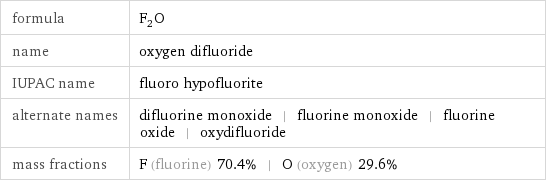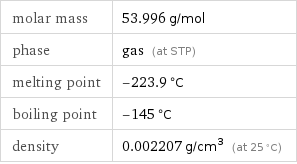Input interpretation

oxygen difluoride
Chemical names and formulas

formula | F_2O name | oxygen difluoride IUPAC name | fluoro hypofluorite alternate names | difluorine monoxide | fluorine monoxide | fluorine oxide | oxydifluoride mass fractions | F (fluorine) 70.4% | O (oxygen) 29.6%
Lewis structure

Draw the Lewis structure of oxygen difluoride. Start by drawing the overall structure of the molecule: Count the total valence electrons of the fluorine (n_F, val = 7) and oxygen (n_O, val = 6) atoms: 2 n_F, val + n_O, val = 20 Calculate the number of electrons needed to completely fill the valence shells for fluorine (n_F, full = 8) and oxygen (n_O, full = 8): 2 n_F, full + n_O, full = 24 Subtracting these two numbers shows that 24 - 20 = 4 bonding electrons are needed. Each bond has two electrons, so the above diagram has all the necessary bonds. There are 2 bonds and hence 4 bonding electrons in the diagram. Lastly, fill in the remaining unbonded electrons on each atom. In total, there remain 20 - 4 = 16 electrons left to draw: Answer: | |
3D structure

3D structure
Basic properties

molar mass | 53.996 g/mol phase | gas (at STP) melting point | -223.9 °C boiling point | -145 °C density | 0.002207 g/cm^3 (at 25 °C)
Units

Gas properties (at STP)

density | 0.002207 g/cm^3 (at 25 °C) vapor density | 1.8 (relative to air) molar volume | 24470 cm^3/mol
Units

Thermodynamic properties

specific heat capacity c_p | gas | 0.5926 J/(g K) molar heat capacity c_p | gas | 32 J/(mol K) specific free energy of formation Δ_fG° | gas | 1.95 kJ/g molar free energy of formation Δ_fG° | gas | 105.3 kJ/mol specific heat of formation Δ_fH° | gas | 2.019 kJ/g molar heat of formation Δ_fH° | gas | 109 kJ/mol specific entropy S° | gas | 4.008 J/(g K) molar entropy S° | gas | 216.4 J/(mol K) critical temperature | 215 K | (at STP)
Chemical identifiers

CAS number | 7783-41-7 PubChem CID number | 24547 SMILES identifier | O(F)F InChI identifier | InChI=1/F2O/c1-3-2 EU number | 231-996-7 Gmelin number | 1054 RTECS number | RS2100000
Toxicity properties

RTECS classes | human data